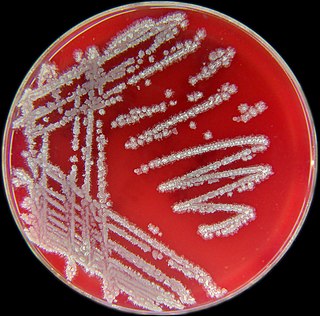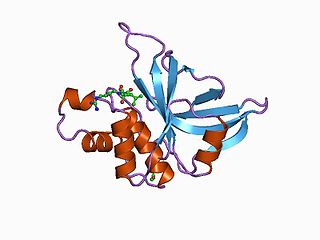Related Research Articles

Coagulase is a protein enzyme produced by several microorganisms that enables the conversion of fibrinogen to fibrin. In the laboratory, it is used to distinguish between different types of Staphylococcus isolates. Importantly, S. aureus is generally coagulase-positive, meaning that a positive coagulase test would indicate the presence of S. aureus or any of the other 11 coagulase-positive Staphylococci. A negative coagulase test would instead show the presence of coagulase-negative organisms such as S. epidermidis or S. saprophyticus. However, it is now known that not all S. aureus are coagulase-positive. Whereas coagulase-positive Staphylococci are usually pathogenic, coagulase-negative Staphylococci are more often associated with opportunistic infection.
A metalloproteinase, or metalloprotease, is any protease enzyme whose catalytic mechanism involves a metal. An example is ADAM12 which plays a significant role in the fusion of muscle cells during embryo development, in a process known as myogenesis.

Staphylococcus haemolyticus is a member of the coagulase-negative staphylococci (CoNS). It is part of the skin flora of humans, and its largest populations are usually found at the axillae, perineum, and inguinal areas. S. haemolyticus also colonizes primates and domestic animals. It is a well-known opportunistic pathogen, and is the second-most frequently isolated CoNS. Infections can be localized or systemic, and are often associated with the insertion of medical devices. The highly antibiotic-resistant phenotype and ability to form biofilms make S. haemolyticus a difficult pathogen to treat. Its most closely related species is Staphylococcus borealis.

Plasminogen activators are serine proteases that catalyze the activation of plasmin via proteolytic cleavage of its zymogen form plasminogen. Plasmin is an important factor in fibrinolysis, the breakdown of fibrin polymers formed during blood clotting. There are two main plasminogen activators: urokinase (uPA) and tissue plasminogen activator (tPA). Tissue plasminogen activators are used to treat medical conditions related to blood clotting including embolic or thrombotic stroke, myocardial infarction, and pulmonary embolism.

Staphylococcus epidermidis is a Gram-positive bacterium, and one of over 40 species belonging to the genus Staphylococcus. It is part of the normal human microbiota, typically the skin microbiota, and less commonly the mucosal microbiota and also found in marine sponges. It is a facultative anaerobic bacteria. Although S. epidermidis is not usually pathogenic, patients with compromised immune systems are at risk of developing infection. These infections are generally hospital-acquired. S. epidermidis is a particular concern for people with catheters or other surgical implants because it is known to form biofilms that grow on these devices. Being part of the normal skin microbiota, S. epidermidis is a frequent contaminant of specimens sent to the diagnostic laboratory.

Bacillus licheniformis is a bacterium commonly found in the soil. It is found on bird feathers, especially chest and back plumage, and most often in ground-dwelling birds and aquatic species.

Subtilisin is a protease initially obtained from Bacillus subtilis.
Lysostaphin is a Staphylococcus simulans metalloendopeptidase. It can function as a bacteriocin (antimicrobial) against Staphylococcus aureus.
Phenol-soluble modulins (PSMs) are a family of small proteins, that carry out a variety of functions, including acting as toxins, assisting in biofilm formation, and colony spreading. PSMs are produced by Staphylococcus bacteria including Methicillin-resistant Staphylococcus aureus (MRSA), and Staphylococcus epidermidis. Many PSMs are encoded within the core genome and can play an important virulence factor. PSMs were first discovered in S. epidermidis by Seymour Klebanoff and via hot-phenol extraction and were described as a pro-inflammatory complex of three peptides. Since their initial discovery, numerous roles of PSMs have been identified. However, due in part to the small size of many PSMs, they have largely gone unnoticed until recent years.

Staphylococcus capitis is a coagulase-negative species (CoNS) of Staphylococcus. It is part of the normal flora of the skin of the human scalp, face, neck, scrotum, and ears and has been associated with prosthetic valve endocarditis, but is rarely associated with native valve infection.

Staphylococcus is a genus of Gram-positive bacteria in the family Staphylococcaceae from the order Bacillales. Under the microscope, they appear spherical (cocci), and form in grape-like clusters. Staphylococcus species are facultative anaerobic organisms.

Subtilases are a family of subtilisin-like serine proteases. They appear to have independently and convergently evolved an Asp/Ser/His catalytic triad, like in the trypsin serine proteases. The structure of proteins in this family shows that they have an alpha/beta fold containing a 7-stranded parallel beta sheet.
Keratinases are proteolytic enzymes that digest keratin.
Gamma-D-glutamyl-meso-diaminopimelate peptidase is an enzyme. This enzyme catalyses the following chemical reaction

Glutamyl endopeptidase is an extracellular bacterial serine protease of the glutamyl endopeptidase I family that was initially isolated from the Staphylococcus aureus strain V8. The protease is, hence, commonly referred to as "V8 protease", or alternatively SspA from its corresponding gene.
Glutamyl endopeptidase II is an enzyme. This enzyme catalyses the following chemical reaction
Staphopain is an enzyme. This enzyme catalyses the following chemical reaction

Aureolysin is an extracellular metalloprotease expressed by Staphylococcus aureus. This protease is a major contributor to the bacterium's virulence, or ability to cause disease, by cleaving host factors of the innate immune system as well as regulating S. aureus secreted toxins and cell wall proteins. To catalyze its enzymatic activities, aureolysin requires zinc and calcium which it obtains from the extracellular environment within the host.

The PA clan is the largest group of proteases with common ancestry as identified by structural homology. Members have a chymotrypsin-like fold and similar proteolysis mechanisms but can have identity of <10%. The clan contains both cysteine and serine proteases. PA clan proteases can be found in plants, animals, fungi, eubacteria, archaea and viruses.

Staphopain A is a secreted cysteine protease produced by Staphylococcus aureus. It was first identified in the S. aureus V8 strain as a papain-like cysteine protease. The protease distinguishes itself from the other major proteases of S. aureus in its very broad specificity and its ability to degrade elastin.
References
- 1 2 3 4 5 6 7 8 Stennicke, Henning R.; Breddam, Klaus (2013-01-01). Rawlings, Neil D.; Salvesen, Guy (eds.). Handbook of Proteolytic Enzymes. Academic Press. pp. 2534–2538. doi:10.1016/b978-0-12-382219-2.00561-5. ISBN 9780123822192.
- ↑ Birktoft, Jens J.; Breddam, Klaus (1994). "[8] Glutamyl endopeptidases" . Proteolytic Enzymes: Serine and Cysteine Peptidases. Methods in Enzymology. Vol. 244. pp. 114–126. doi:10.1016/0076-6879(94)44010-7. ISBN 9780121821456. PMID 7845201.
- 1 2 3 Dubin, Grzegorz (2002-07-01). "Extracellular proteases of Staphylococcus spp". Biological Chemistry. 383 (7–8): 1075–1086. doi:10.1515/BC.2002.116. ISSN 1431-6730. PMID 12437090. S2CID 23295763.
- ↑ Ohara-Nemoto, Yuko; Ikeda, Yoriko; Kobayashi, Masahiko; Sasaki, Minoru; Tajika, Shihoko; Kimura, Shigenobu (2002-07-01). "Characterization and molecular cloning of a glutamyl endopeptidase from Staphylococcus epidermidis". Microbial Pathogenesis. 33 (1): 33–41. doi:10.1006/mpat.2002.0515. ISSN 0882-4010. PMID 12127798.
- ↑ Yokoi, K.; Kakikawa, M.; Kimoto, H.; Watanabe, K.; Yasukawa, H.; Yamakawa, A.; Taketo, A.; Kodaira, K. I. (2001-12-27). "Genetic and biochemical characterization of glutamyl endopeptidase of Staphylococcus warneri M". Gene. 281 (1–2): 115–122. doi:10.1016/S0378-1119(01)00782-X. ISSN 0378-1119. PMID 11750133.
- ↑ Kawalec, Magdalena; Potempa, Jan; Moon, Jonathan L.; Travis, James; Murray, Barbara E. (2005-01-01). "Molecular diversity of a putative virulence factor: purification and characterization of isoforms of an extracellular serine glutamyl endopeptidase of Enterococcus faecalis with different enzymatic activities". Journal of Bacteriology. 187 (1): 266–275. doi:10.1128/JB.187.1.266-275.2005. ISSN 0021-9193. PMC 538807 . PMID 15601711.
- ↑ Chao, Yun-Peng; Fu, Hongyong; Wang, Yu-Ling; Huang, Wen-Bin; Wang, Jen-You (2003-09-01). "Molecular cloning of the carboxylesterase gene and biochemical characterization of the encoded protein from Pseudomonas citronellolis ATCC 13674". Research in Microbiology. 154 (7): 521–526. doi: 10.1016/S0923-2508(03)00144-X . ISSN 0923-2508. PMID 14499938.
- ↑ Yokoi, Ken-Ji; Kuzuwa, Shinya; Iwasaki, Shu-Ichi; Yamakawa, Ayanori; Taketo, Akira; Kodaira, Ken-Ichi (2016-06-01). "Aureolysin of Staphylococcus warneri M accelerates its proteolytic cascade, and participates in biofilm formation". Bioscience, Biotechnology, and Biochemistry. 80 (6): 1238–1242. doi: 10.1080/09168451.2016.1148576 . ISSN 1347-6947. PMID 27008278.
- ↑ Iwase, Tadayuki; Uehara, Yoshio; Shinji, Hitomi; Tajima, Akiko; Seo, Hiromi; Takada, Koji; Agata, Toshihiko; Mizunoe, Yoshimitsu (2010-05-20). "Staphylococcus epidermidis Esp inhibits Staphylococcus aureus biofilm formation and nasal colonization". Nature. 465 (7296): 346–349. Bibcode:2010Natur.465..346I. doi:10.1038/nature09074. ISSN 1476-4687. PMID 20485435. S2CID 4392908.
- ↑ Koziel, Joanna; Potempa, Jan (2013-02-01). "Protease-armed bacteria in the skin". Cell and Tissue Research. 351 (2): 325–337. doi:10.1007/s00441-012-1355-2. ISSN 1432-0878. PMC 3560952 . PMID 22358849.
- ↑ Chen, Chen; Krishnan, Vengadesan; Macon, Kevin; Manne, Kartik; Narayana, Sthanam V. L.; Schneewind, Olaf (2013-10-11). "Secreted proteases control autolysin-mediated biofilm growth of Staphylococcus aureus". The Journal of Biological Chemistry. 288 (41): 29440–29452. doi: 10.1074/jbc.M113.502039 . ISSN 1083-351X. PMC 3795244 . PMID 23970550.